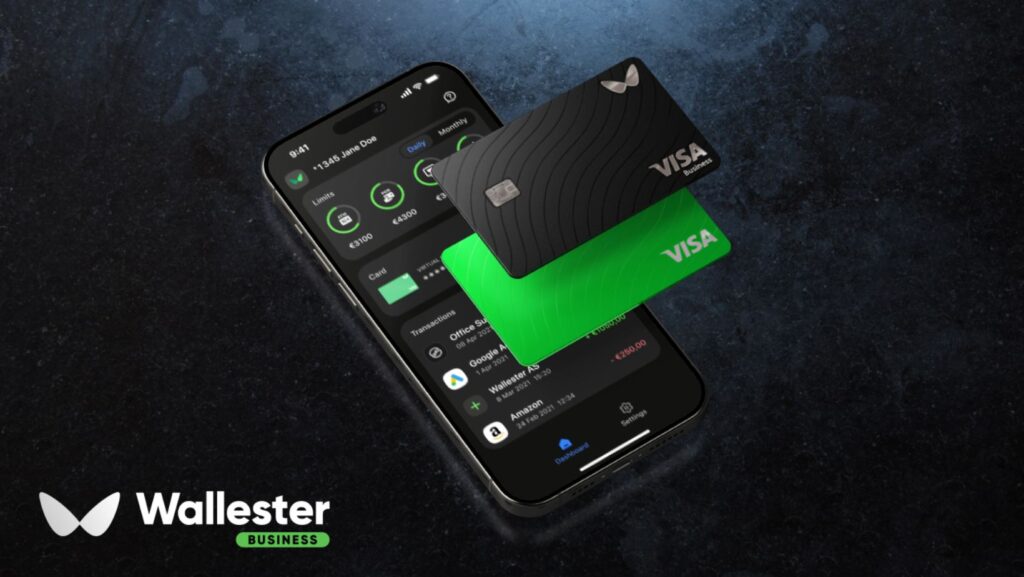In many companies still relying on traditional expense management methods, employees must pay for business-related expenses out of their own pockets. They are then required to submit receipts, fill out detailed expense reports, and wait — often weeks or even months — for reimbursement. This approach is inconvenient for employees and finance teams, who must dedicate time and resources to process reimbursements and maintain accurate records.
With advancements in financial technology, managing corporate expenses has become significantly more efficient. Employee expense cards, such as those available through the Wallester Business platform, provide a modern solution to this longstanding challenge. These cards grant employees access to company funds with pre-set limits tailored to their roles, offering a streamlined and secure method for managing business expenses. Whether physical or virtual, these cards play a critical role in simplifying expense management while maintaining financial control.
What Are Employee Expense Cards?
To establish an effective financial management system, businesses must maintain complete control over their expenditures. Employee expense cards offer a practical way to achieve this by enabling real-time monitoring of transactions and minimizing the risk of unauthorized spending. Through a card program management platform, all expenses — whether for online or offline purchases — are tracked and displayed in real-time, providing transparency and accountability.
For employees, these cards eliminate the need to seek multiple levels of approval or wait for reimbursements. Funds are readily available for business-related purchases, with spending limits and restrictions tailored to their job responsibilities. Expense cards come in two primary types:
- Prepaid Cards: These require funds to be loaded in advance. They come with specific usage rules and spending restrictions.
- Debit Cards: Linked directly to a corporate account, these cards debit funds immediately upon purchase. They generally have fewer restrictions than prepaid cards.
Both types simplify the accounting process for finance teams while offering employees greater convenience. By automating much of the expense reporting process, these cards save time and reduce administrative burdens across the organization.
How Do Employee Expense Cards Work?
Employee expense cards are issued and managed via platforms like Wallester Business. The process begins with the finance team creating cards tailored to specific employees or roles within the company. Each card comes with a defined spending limit and usage rules, ensuring funds are allocated responsibly and in line with the employee’s job description.
For instance, consider a marketing team member who frequently travels for work. They may receive a card that restricts purchases to transportation and marketing services, with a $1,000 monthly limit. This ensures they can cover legitimate business expenses — such as taxis, car rentals, or public transport — without exceeding the budget. If the funds are depleted or used for unauthorized purchases, the finance team is notified instantly, and all transactions are documented in automatically generated financial reports.
This level of control and visibility is invaluable for maintaining security and accountability. Employees can focus on their work without worrying about reimbursement delays, while finance teams gain real-time oversight of company spending.
Key Benefits of Employee Expense Cards
Enhanced Spending Control
Expense cards allow businesses to set precise spending limits for employees, reducing the risk of overspending or misuse. Every transaction can be monitored and categorized, giving the finance team a clear picture of where funds are being allocated.
Simplified Reporting
Gone are the days of collecting paper receipts and compiling manual reports. With expense cards, employees can upload receipts or invoices directly through a mobile app, where they are instantly accessible to the finance department. This seamless process improves accuracy and speeds up reporting.
Real-Time Expense Tracking
The Wallester Business platform provides real-time data on all transactions, offering detailed insights into spending patterns. Special filters make it easy to organize expenses by category, amount, or time period, enabling faster and more efficient reporting.
Flexibility for Online and Virtual Payments
As contactless and online payments become increasingly prevalent, expense cards — physical and virtual — offer employees the flexibility to make purchases wherever they are.

Virtual cards, in particular, are ideal for online services like social media advertising or software subscriptions and can be issued instantly.
Seamless Integration
Built on a REST API, the Wallester Business platform integrates easily with existing company systems, eliminating the need for major overhauls of financial infrastructure. This compatibility ensures businesses can adopt the system without disrupting their operations.
Scalability
One of the standout features of the Wallester Business platform is its ability to issue an unlimited number of cards instantly. This scalability is particularly useful for growing companies that need to equip multiple employees with expense cards quickly and efficiently.
An Example of Expense Cards in Action
Imagine a logistics company with a fleet of drivers responsible for deliveries across the country. Each driver is issued a prepaid expense card limited to fuel and vehicle maintenance costs, with a monthly cap of $500. The drivers can make necessary purchases without delays or additional approvals. If a driver attempts to use the card for unauthorized expenses, the finance department is immediately alerted, and the transaction is flagged in the system.
This system ensures that company funds are used appropriately and also minimizes administrative workload. Finance teams no longer need to reconcile stacks of receipts or chase employees for missing documentation. Instead, every transaction is automatically recorded, categorized, and included in comprehensive financial reports.
Why Modern Businesses Need Expense Cards
As the adoption of digital payments grows, employee expense cards represent a vital tool for businesses striving to enhance efficiency and control. They simplify the reimbursement process, provide greater transparency, and integrate seamlessly with existing financial systems.
For the finance department, expense cards streamline reporting and enable better expense tracking. For employees, they eliminate the frustration of out-of-pocket spending and lengthy reimbursement cycles. By adopting this technology, businesses can save time, reduce errors, and improve overall financial management.
Conclusion
Employee expense cards are more than just a convenient payment solution — they are a game-changer for corporate financial management.

By providing employees with immediate access to company funds while maintaining strict controls and real-time visibility, these cards benefit employees and finance teams alike. Platforms like Wallester Business make it easy to issue, manage, and monitor these cards, offering a scalable and efficient solution for businesses of all sizes. As digital payments continue to dominate, adopting employee expense cards is a forward-thinking step toward financial optimization.


